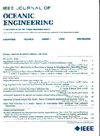A Comparative Study of Reverse Engineering Approaches Toward the Design and Analysis of 2-D High-Speed Hydrofoils
IF 5.3
2区 工程技术
Q1 ENGINEERING, CIVIL
引用次数: 0
Abstract
In recent years, maritime industries have focused their attention on hydrofoils as one of the main technologies for the development of eco-sustainable solutions in the field of boating. The aim of the current research was to analyze the front wing of a二维高速水翼设计与分析的逆向工程方法比较研究
近年来,水翼船作为发展生态可持续解决方案的主要技术之一,受到海事行业的关注。当前研究的目的是分析一个Kohlkida类水翼船的前翼,并描述了采用的方法为重建的2-D翼型的摄影测量的手段。考虑到摄影测量方法的局限性,从模型中提取了部分剖面。对翼型进行了适当的缩放,并首先与激光扫描仪得到的模型进行了比较。在水翼的工作条件下,使用reynolds -average Navier-Stokes模拟,模拟了翼型的行为,使我们能够验证由于摄影测量方法引起的几何差异如何影响流体动力学,并与激光扫描获得的模型进行了比较。所提出的方法导致几何重建具有足够的精度来识别升力和阻力系数的特征曲线,在研究中调查的攻角范围内的最大误差为6%,同时也突出了具有平底和锋利前缘的这类翼型的流体动力学问题。
本文章由计算机程序翻译,如有差异,请以英文原文为准。
求助全文
约1分钟内获得全文
求助全文
来源期刊

IEEE Journal of Oceanic Engineering
工程技术-工程:大洋
CiteScore
9.60
自引率
12.20%
发文量
86
审稿时长
12 months
期刊介绍:
The IEEE Journal of Oceanic Engineering (ISSN 0364-9059) is the online-only quarterly publication of the IEEE Oceanic Engineering Society (IEEE OES). The scope of the Journal is the field of interest of the IEEE OES, which encompasses all aspects of science, engineering, and technology that address research, development, and operations pertaining to all bodies of water. This includes the creation of new capabilities and technologies from concept design through prototypes, testing, and operational systems to sense, explore, understand, develop, use, and responsibly manage natural resources.
 求助内容:
求助内容: 应助结果提醒方式:
应助结果提醒方式:


